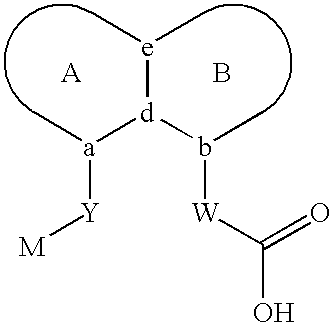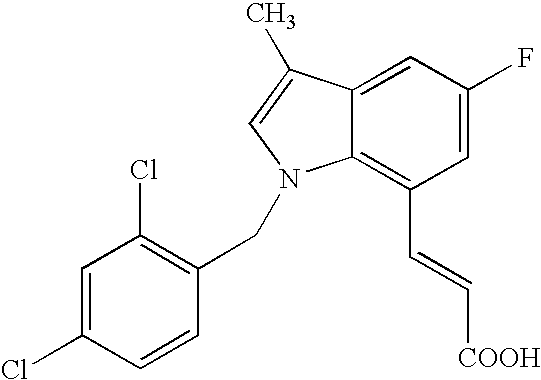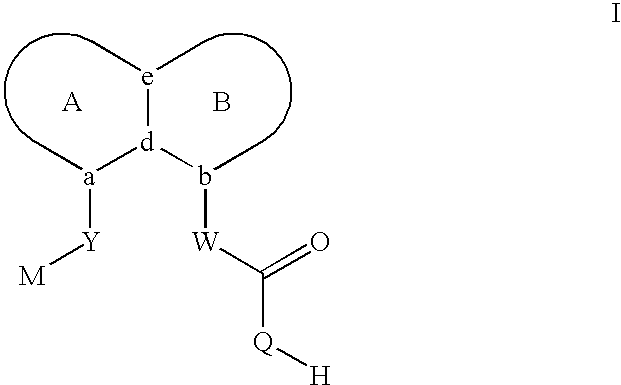Carboxylic acid peri-substituted bicyclics for occlusive artery disease
a carboxylic acid and peri-substituted technology, applied in the chemical genus of peri-substituted bicyclic acids, can solve the problems of general ineffective medical treatment, and achieve the effect of increasing regional blood flow and inhibiting platelet aggregation
- Summary
- Abstract
- Description
- Claims
- Application Information
AI Technical Summary
Benefits of technology
Problems solved by technology
Method used
Image
Examples
example 1
Preparation of A25
[0118]2-Fluoro-6-(naphthalen-2-yloxy)-benzonitrile (K-1). To a 20 mL vial containing a magnetic stir bar was added sodium hydride (103.7 mg, 4.32 mmol, 60% in mineral oil) followed by anhydrous DMF (2 mL) resulting in gas evolution. To this stirring reaction mixture was added 2-naphthol (623 mg, 4.32 mmol) as a solid in small portions over 5 min. The mixture was stirred at room temperature for 3 min and then 2,6-difluorobenzonitrile (601 mg, 4.32 mmol) in anhydrous DMF (4 mL) was added in one portion. The reaction mixture was heated in an oil bath at 100 ° C. for a total of 2 h and allowed to cool to room temperature. The reaction mixture was diluted with water (15 mL) and the resulting mixture was extracted with EtOAc (2×20 mL). The combined organic extracts were washed with water (3×20 mL), dried (Na2SO4), filtered and concentrated to give K-1 as brown solid (1.216 g) of sufficient purity (contained 2-naphthol) to be used in the subsequent step. 1H NMR.
[0119]1-Me...
example 2
Preparation of A26
[0122]4-Iodo-1-methyl-1H-indazol-3-ylamine (K-4). To a 50 mL pressure vessel was added 2-fluoro-6-iodobenzonitrile (500 mg, 2.02 mmol) and N,N-dimethylacetamide (5 mL). To this stirring solution was added methyl hydrazine (139 μL, 2.63 mmol) and the sealed vessel was heated to 80° C. for 2 h followed by heating at 120° C. for 16 h. The cooled reaction mixture was diluted with water and extracted with EtOAc (3×). The combined organic extracts were washed with water, dried (Na2SO4), filtered and concentrated. The resulting semisolid was triturated with hexanes / EtOAc (1:1) and the resulting solid was filtered, washed with EtOAc and dried. This operation afforded 149 mg of a light brown solid. The aqueous washes from above were extracted with EtOAc to afford an additional 327 mg of product. Total yield was 476 mg (85%) of K-4. 1H NMR, MS.
[0123]Naphthalene-2-carboxylic acid (4-iodo-1-methyl-1H-indazol-3-yl)-amide (K-5). To an oven-dried 25 mL, three-necked, round-bottom...
example 3
Preparation of A02
[0126]Synthesis of 5-Amino-1-(2,2-diethoxy-ethyl)-1H-pyrazole-4-carboxylic acid ethyl ester, K-7. To a solution of hydrazine hydrate (17.5 mL, 0.355 moles) in 60 mL absolute ethanol stirred at reflux temperature was added bromoacetaldehyde diethylacetal (20 g, 0.101 moles) dropwise and the resulting mixture was heated at refluxed overnight. The cooled reaction mixture was concentrated in vacuo and aqueous 35% NaOH containing 3 g NaCl (25 mL) was added and this solution was extracted with ether (2×100 mL). Combined organics were dried over MgSO4 and concentrated in vacuo to afford 12.3 g of an oil . To a solution of this crude (2,2-diethoxy-ethyl)-hydrazine (12.3 g, 0.0831 moles) in 25 mL absolute ethanol was added a solution of ethyl ethoxymethylene cyanoacetate (14 g, 0.0831 moles) in 75 mL absolute ethanol. The mixture was stirred at room temperature for 3 days. Solvent was removed and oily crude residue K-7 was used without further purification. 1H NMR.
[0127]Syn...
PUM
| Property | Measurement | Unit |
|---|---|---|
| temperature | aaaaa | aaaaa |
| temperature | aaaaa | aaaaa |
| temperature | aaaaa | aaaaa |
Abstract
Description
Claims
Application Information
 Login to view more
Login to view more - R&D Engineer
- R&D Manager
- IP Professional
- Industry Leading Data Capabilities
- Powerful AI technology
- Patent DNA Extraction
Browse by: Latest US Patents, China's latest patents, Technical Efficacy Thesaurus, Application Domain, Technology Topic.
© 2024 PatSnap. All rights reserved.Legal|Privacy policy|Modern Slavery Act Transparency Statement|Sitemap



